Essay Analysis: Richard Dorment's 'Why Men Still Can't Have it All'
VerifiedAdded on 2022/08/19
|6
|2130
|33
Essay
AI Summary
This essay critically analyzes Richard Dorment's 'Why Men Still Can't Have It All,' examining his arguments on work-life balance and gender equality. The essay critiques Dorment's perspective, arguing that his claims of equal struggles for men and women overlook significant societal disparities, such as pregnancy discrimination and the motherhood penalty. It draws on newspaper articles to support its counter-arguments, highlighting how men often benefit from parenthood while women face career setbacks. The analysis concludes that Dorment's argument is flawed due to its failure to address historical and fundamental inequalities, lack of organization, and incomplete understanding of the 'have it all' concept. The essay suggests improvements to his argument and emphasizes the need for a more nuanced discussion of gender-specific challenges in achieving work-life balance, while acknowledging the importance of individual choice.
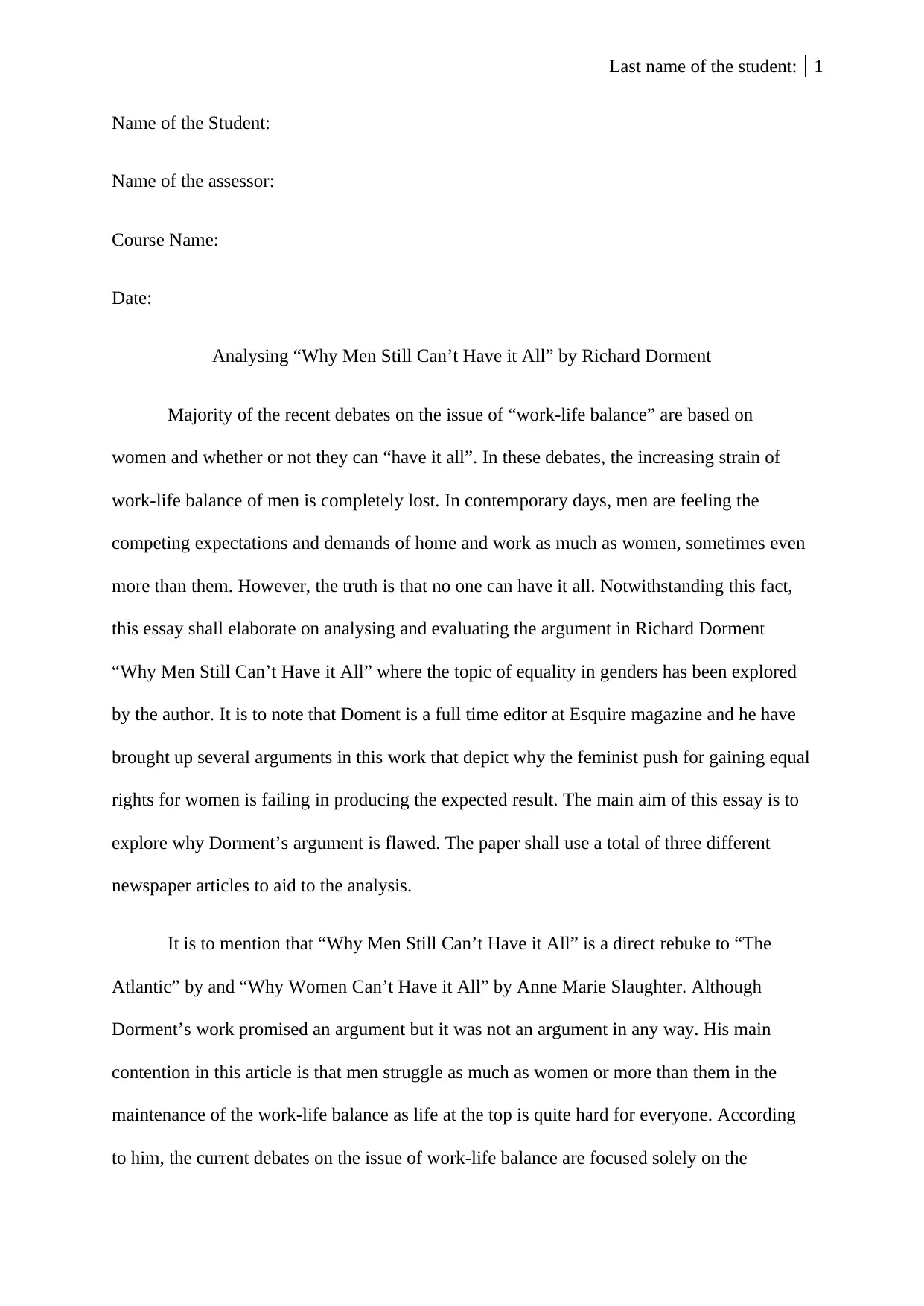
Last name of the student: 1
Name of the Student:
Name of the assessor:
Course Name:
Date:
Analysing “Why Men Still Can’t Have it All” by Richard Dorment
Majority of the recent debates on the issue of “work-life balance” are based on
women and whether or not they can “have it all”. In these debates, the increasing strain of
work-life balance of men is completely lost. In contemporary days, men are feeling the
competing expectations and demands of home and work as much as women, sometimes even
more than them. However, the truth is that no one can have it all. Notwithstanding this fact,
this essay shall elaborate on analysing and evaluating the argument in Richard Dorment
“Why Men Still Can’t Have it All” where the topic of equality in genders has been explored
by the author. It is to note that Doment is a full time editor at Esquire magazine and he have
brought up several arguments in this work that depict why the feminist push for gaining equal
rights for women is failing in producing the expected result. The main aim of this essay is to
explore why Dorment’s argument is flawed. The paper shall use a total of three different
newspaper articles to aid to the analysis.
It is to mention that “Why Men Still Can’t Have it All” is a direct rebuke to “The
Atlantic” by and “Why Women Can’t Have it All” by Anne Marie Slaughter. Although
Dorment’s work promised an argument but it was not an argument in any way. His main
contention in this article is that men struggle as much as women or more than them in the
maintenance of the work-life balance as life at the top is quite hard for everyone. According
to him, the current debates on the issue of work-life balance are focused solely on the
Name of the Student:
Name of the assessor:
Course Name:
Date:
Analysing “Why Men Still Can’t Have it All” by Richard Dorment
Majority of the recent debates on the issue of “work-life balance” are based on
women and whether or not they can “have it all”. In these debates, the increasing strain of
work-life balance of men is completely lost. In contemporary days, men are feeling the
competing expectations and demands of home and work as much as women, sometimes even
more than them. However, the truth is that no one can have it all. Notwithstanding this fact,
this essay shall elaborate on analysing and evaluating the argument in Richard Dorment
“Why Men Still Can’t Have it All” where the topic of equality in genders has been explored
by the author. It is to note that Doment is a full time editor at Esquire magazine and he have
brought up several arguments in this work that depict why the feminist push for gaining equal
rights for women is failing in producing the expected result. The main aim of this essay is to
explore why Dorment’s argument is flawed. The paper shall use a total of three different
newspaper articles to aid to the analysis.
It is to mention that “Why Men Still Can’t Have it All” is a direct rebuke to “The
Atlantic” by and “Why Women Can’t Have it All” by Anne Marie Slaughter. Although
Dorment’s work promised an argument but it was not an argument in any way. His main
contention in this article is that men struggle as much as women or more than them in the
maintenance of the work-life balance as life at the top is quite hard for everyone. According
to him, the current debates on the issue of work-life balance are focused solely on the
Paraphrase This Document
Need a fresh take? Get an instant paraphrase of this document with our AI Paraphraser
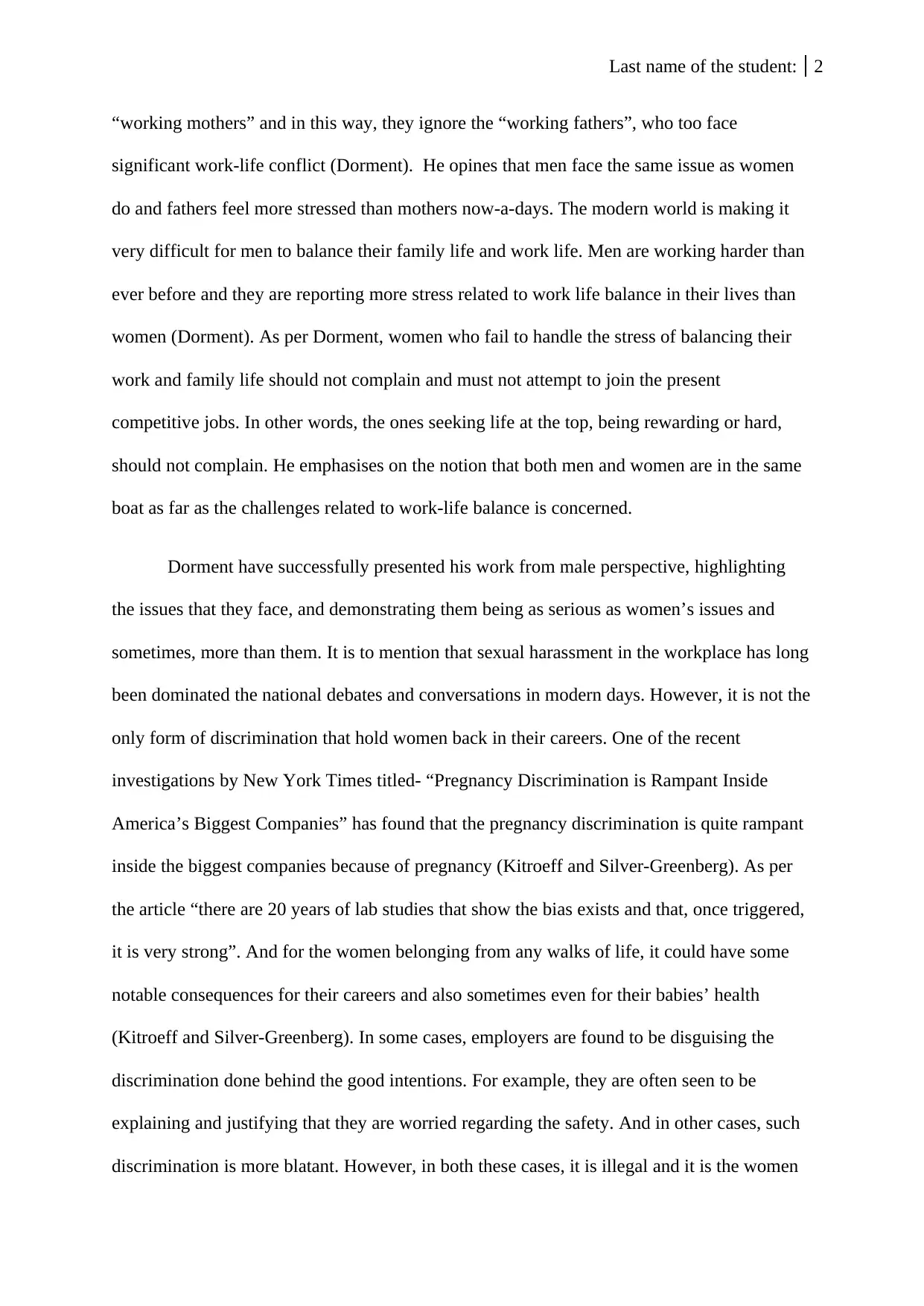
Last name of the student: 2
“working mothers” and in this way, they ignore the “working fathers”, who too face
significant work-life conflict (Dorment). He opines that men face the same issue as women
do and fathers feel more stressed than mothers now-a-days. The modern world is making it
very difficult for men to balance their family life and work life. Men are working harder than
ever before and they are reporting more stress related to work life balance in their lives than
women (Dorment). As per Dorment, women who fail to handle the stress of balancing their
work and family life should not complain and must not attempt to join the present
competitive jobs. In other words, the ones seeking life at the top, being rewarding or hard,
should not complain. He emphasises on the notion that both men and women are in the same
boat as far as the challenges related to work-life balance is concerned.
Dorment have successfully presented his work from male perspective, highlighting
the issues that they face, and demonstrating them being as serious as women’s issues and
sometimes, more than them. It is to mention that sexual harassment in the workplace has long
been dominated the national debates and conversations in modern days. However, it is not the
only form of discrimination that hold women back in their careers. One of the recent
investigations by New York Times titled- “Pregnancy Discrimination is Rampant Inside
America’s Biggest Companies” has found that the pregnancy discrimination is quite rampant
inside the biggest companies because of pregnancy (Kitroeff and Silver-Greenberg). As per
the article “there are 20 years of lab studies that show the bias exists and that, once triggered,
it is very strong”. And for the women belonging from any walks of life, it could have some
notable consequences for their careers and also sometimes even for their babies’ health
(Kitroeff and Silver-Greenberg). In some cases, employers are found to be disguising the
discrimination done behind the good intentions. For example, they are often seen to be
explaining and justifying that they are worried regarding the safety. And in other cases, such
discrimination is more blatant. However, in both these cases, it is illegal and it is the women
“working mothers” and in this way, they ignore the “working fathers”, who too face
significant work-life conflict (Dorment). He opines that men face the same issue as women
do and fathers feel more stressed than mothers now-a-days. The modern world is making it
very difficult for men to balance their family life and work life. Men are working harder than
ever before and they are reporting more stress related to work life balance in their lives than
women (Dorment). As per Dorment, women who fail to handle the stress of balancing their
work and family life should not complain and must not attempt to join the present
competitive jobs. In other words, the ones seeking life at the top, being rewarding or hard,
should not complain. He emphasises on the notion that both men and women are in the same
boat as far as the challenges related to work-life balance is concerned.
Dorment have successfully presented his work from male perspective, highlighting
the issues that they face, and demonstrating them being as serious as women’s issues and
sometimes, more than them. It is to mention that sexual harassment in the workplace has long
been dominated the national debates and conversations in modern days. However, it is not the
only form of discrimination that hold women back in their careers. One of the recent
investigations by New York Times titled- “Pregnancy Discrimination is Rampant Inside
America’s Biggest Companies” has found that the pregnancy discrimination is quite rampant
inside the biggest companies because of pregnancy (Kitroeff and Silver-Greenberg). As per
the article “there are 20 years of lab studies that show the bias exists and that, once triggered,
it is very strong”. And for the women belonging from any walks of life, it could have some
notable consequences for their careers and also sometimes even for their babies’ health
(Kitroeff and Silver-Greenberg). In some cases, employers are found to be disguising the
discrimination done behind the good intentions. For example, they are often seen to be
explaining and justifying that they are worried regarding the safety. And in other cases, such
discrimination is more blatant. However, in both these cases, it is illegal and it is the women
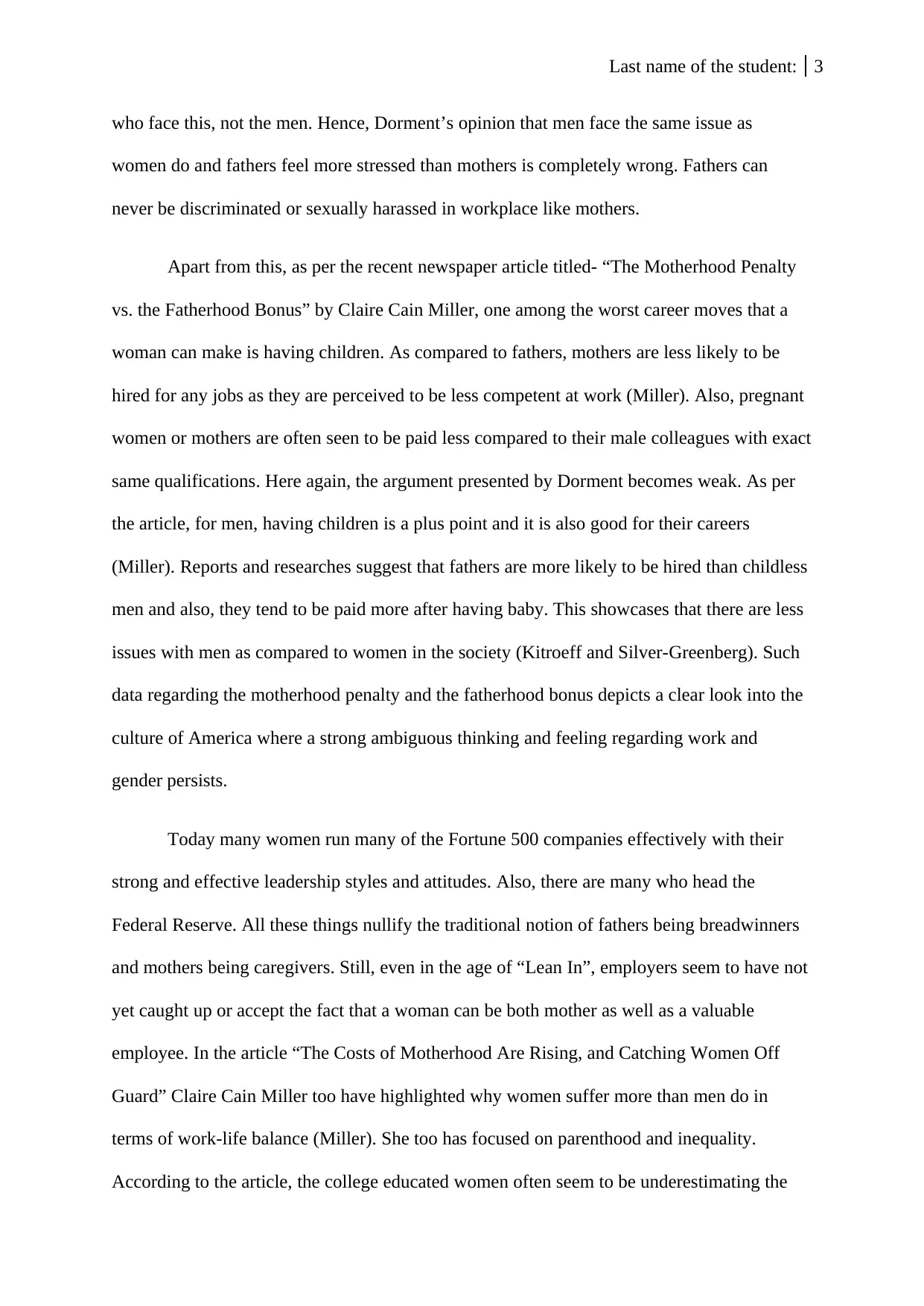
Last name of the student: 3
who face this, not the men. Hence, Dorment’s opinion that men face the same issue as
women do and fathers feel more stressed than mothers is completely wrong. Fathers can
never be discriminated or sexually harassed in workplace like mothers.
Apart from this, as per the recent newspaper article titled- “The Motherhood Penalty
vs. the Fatherhood Bonus” by Claire Cain Miller, one among the worst career moves that a
woman can make is having children. As compared to fathers, mothers are less likely to be
hired for any jobs as they are perceived to be less competent at work (Miller). Also, pregnant
women or mothers are often seen to be paid less compared to their male colleagues with exact
same qualifications. Here again, the argument presented by Dorment becomes weak. As per
the article, for men, having children is a plus point and it is also good for their careers
(Miller). Reports and researches suggest that fathers are more likely to be hired than childless
men and also, they tend to be paid more after having baby. This showcases that there are less
issues with men as compared to women in the society (Kitroeff and Silver-Greenberg). Such
data regarding the motherhood penalty and the fatherhood bonus depicts a clear look into the
culture of America where a strong ambiguous thinking and feeling regarding work and
gender persists.
Today many women run many of the Fortune 500 companies effectively with their
strong and effective leadership styles and attitudes. Also, there are many who head the
Federal Reserve. All these things nullify the traditional notion of fathers being breadwinners
and mothers being caregivers. Still, even in the age of “Lean In”, employers seem to have not
yet caught up or accept the fact that a woman can be both mother as well as a valuable
employee. In the article “The Costs of Motherhood Are Rising, and Catching Women Off
Guard” Claire Cain Miller too have highlighted why women suffer more than men do in
terms of work-life balance (Miller). She too has focused on parenthood and inequality.
According to the article, the college educated women often seem to be underestimating the
who face this, not the men. Hence, Dorment’s opinion that men face the same issue as
women do and fathers feel more stressed than mothers is completely wrong. Fathers can
never be discriminated or sexually harassed in workplace like mothers.
Apart from this, as per the recent newspaper article titled- “The Motherhood Penalty
vs. the Fatherhood Bonus” by Claire Cain Miller, one among the worst career moves that a
woman can make is having children. As compared to fathers, mothers are less likely to be
hired for any jobs as they are perceived to be less competent at work (Miller). Also, pregnant
women or mothers are often seen to be paid less compared to their male colleagues with exact
same qualifications. Here again, the argument presented by Dorment becomes weak. As per
the article, for men, having children is a plus point and it is also good for their careers
(Miller). Reports and researches suggest that fathers are more likely to be hired than childless
men and also, they tend to be paid more after having baby. This showcases that there are less
issues with men as compared to women in the society (Kitroeff and Silver-Greenberg). Such
data regarding the motherhood penalty and the fatherhood bonus depicts a clear look into the
culture of America where a strong ambiguous thinking and feeling regarding work and
gender persists.
Today many women run many of the Fortune 500 companies effectively with their
strong and effective leadership styles and attitudes. Also, there are many who head the
Federal Reserve. All these things nullify the traditional notion of fathers being breadwinners
and mothers being caregivers. Still, even in the age of “Lean In”, employers seem to have not
yet caught up or accept the fact that a woman can be both mother as well as a valuable
employee. In the article “The Costs of Motherhood Are Rising, and Catching Women Off
Guard” Claire Cain Miller too have highlighted why women suffer more than men do in
terms of work-life balance (Miller). She too has focused on parenthood and inequality.
According to the article, the college educated women often seem to be underestimating the
⊘ This is a preview!⊘
Do you want full access?
Subscribe today to unlock all pages.

Trusted by 1+ million students worldwide
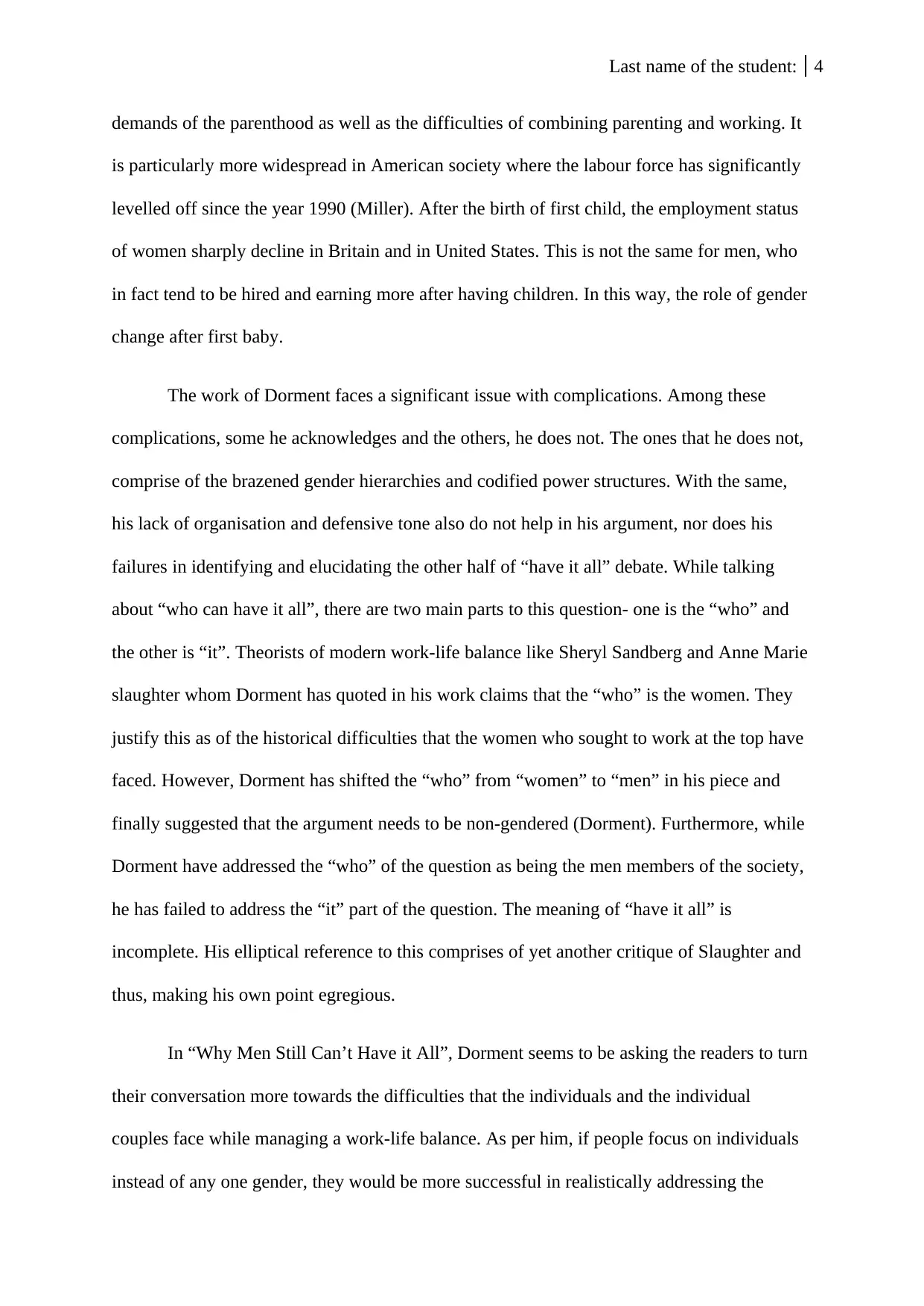
Last name of the student: 4
demands of the parenthood as well as the difficulties of combining parenting and working. It
is particularly more widespread in American society where the labour force has significantly
levelled off since the year 1990 (Miller). After the birth of first child, the employment status
of women sharply decline in Britain and in United States. This is not the same for men, who
in fact tend to be hired and earning more after having children. In this way, the role of gender
change after first baby.
The work of Dorment faces a significant issue with complications. Among these
complications, some he acknowledges and the others, he does not. The ones that he does not,
comprise of the brazened gender hierarchies and codified power structures. With the same,
his lack of organisation and defensive tone also do not help in his argument, nor does his
failures in identifying and elucidating the other half of “have it all” debate. While talking
about “who can have it all”, there are two main parts to this question- one is the “who” and
the other is “it”. Theorists of modern work-life balance like Sheryl Sandberg and Anne Marie
slaughter whom Dorment has quoted in his work claims that the “who” is the women. They
justify this as of the historical difficulties that the women who sought to work at the top have
faced. However, Dorment has shifted the “who” from “women” to “men” in his piece and
finally suggested that the argument needs to be non-gendered (Dorment). Furthermore, while
Dorment have addressed the “who” of the question as being the men members of the society,
he has failed to address the “it” part of the question. The meaning of “have it all” is
incomplete. His elliptical reference to this comprises of yet another critique of Slaughter and
thus, making his own point egregious.
In “Why Men Still Can’t Have it All”, Dorment seems to be asking the readers to turn
their conversation more towards the difficulties that the individuals and the individual
couples face while managing a work-life balance. As per him, if people focus on individuals
instead of any one gender, they would be more successful in realistically addressing the
demands of the parenthood as well as the difficulties of combining parenting and working. It
is particularly more widespread in American society where the labour force has significantly
levelled off since the year 1990 (Miller). After the birth of first child, the employment status
of women sharply decline in Britain and in United States. This is not the same for men, who
in fact tend to be hired and earning more after having children. In this way, the role of gender
change after first baby.
The work of Dorment faces a significant issue with complications. Among these
complications, some he acknowledges and the others, he does not. The ones that he does not,
comprise of the brazened gender hierarchies and codified power structures. With the same,
his lack of organisation and defensive tone also do not help in his argument, nor does his
failures in identifying and elucidating the other half of “have it all” debate. While talking
about “who can have it all”, there are two main parts to this question- one is the “who” and
the other is “it”. Theorists of modern work-life balance like Sheryl Sandberg and Anne Marie
slaughter whom Dorment has quoted in his work claims that the “who” is the women. They
justify this as of the historical difficulties that the women who sought to work at the top have
faced. However, Dorment has shifted the “who” from “women” to “men” in his piece and
finally suggested that the argument needs to be non-gendered (Dorment). Furthermore, while
Dorment have addressed the “who” of the question as being the men members of the society,
he has failed to address the “it” part of the question. The meaning of “have it all” is
incomplete. His elliptical reference to this comprises of yet another critique of Slaughter and
thus, making his own point egregious.
In “Why Men Still Can’t Have it All”, Dorment seems to be asking the readers to turn
their conversation more towards the difficulties that the individuals and the individual
couples face while managing a work-life balance. As per him, if people focus on individuals
instead of any one gender, they would be more successful in realistically addressing the
Paraphrase This Document
Need a fresh take? Get an instant paraphrase of this document with our AI Paraphraser
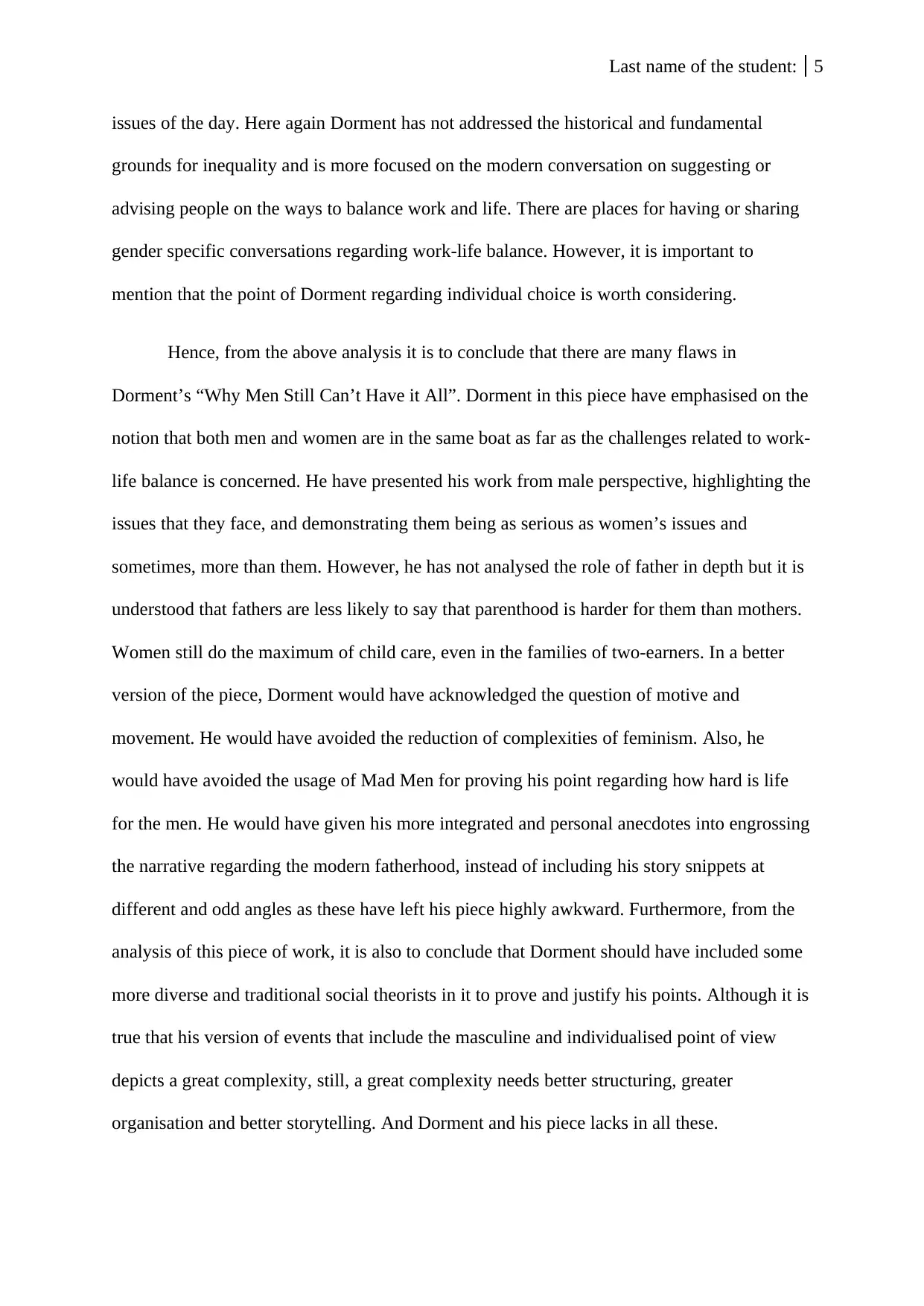
Last name of the student: 5
issues of the day. Here again Dorment has not addressed the historical and fundamental
grounds for inequality and is more focused on the modern conversation on suggesting or
advising people on the ways to balance work and life. There are places for having or sharing
gender specific conversations regarding work-life balance. However, it is important to
mention that the point of Dorment regarding individual choice is worth considering.
Hence, from the above analysis it is to conclude that there are many flaws in
Dorment’s “Why Men Still Can’t Have it All”. Dorment in this piece have emphasised on the
notion that both men and women are in the same boat as far as the challenges related to work-
life balance is concerned. He have presented his work from male perspective, highlighting the
issues that they face, and demonstrating them being as serious as women’s issues and
sometimes, more than them. However, he has not analysed the role of father in depth but it is
understood that fathers are less likely to say that parenthood is harder for them than mothers.
Women still do the maximum of child care, even in the families of two-earners. In a better
version of the piece, Dorment would have acknowledged the question of motive and
movement. He would have avoided the reduction of complexities of feminism. Also, he
would have avoided the usage of Mad Men for proving his point regarding how hard is life
for the men. He would have given his more integrated and personal anecdotes into engrossing
the narrative regarding the modern fatherhood, instead of including his story snippets at
different and odd angles as these have left his piece highly awkward. Furthermore, from the
analysis of this piece of work, it is also to conclude that Dorment should have included some
more diverse and traditional social theorists in it to prove and justify his points. Although it is
true that his version of events that include the masculine and individualised point of view
depicts a great complexity, still, a great complexity needs better structuring, greater
organisation and better storytelling. And Dorment and his piece lacks in all these.
issues of the day. Here again Dorment has not addressed the historical and fundamental
grounds for inequality and is more focused on the modern conversation on suggesting or
advising people on the ways to balance work and life. There are places for having or sharing
gender specific conversations regarding work-life balance. However, it is important to
mention that the point of Dorment regarding individual choice is worth considering.
Hence, from the above analysis it is to conclude that there are many flaws in
Dorment’s “Why Men Still Can’t Have it All”. Dorment in this piece have emphasised on the
notion that both men and women are in the same boat as far as the challenges related to work-
life balance is concerned. He have presented his work from male perspective, highlighting the
issues that they face, and demonstrating them being as serious as women’s issues and
sometimes, more than them. However, he has not analysed the role of father in depth but it is
understood that fathers are less likely to say that parenthood is harder for them than mothers.
Women still do the maximum of child care, even in the families of two-earners. In a better
version of the piece, Dorment would have acknowledged the question of motive and
movement. He would have avoided the reduction of complexities of feminism. Also, he
would have avoided the usage of Mad Men for proving his point regarding how hard is life
for the men. He would have given his more integrated and personal anecdotes into engrossing
the narrative regarding the modern fatherhood, instead of including his story snippets at
different and odd angles as these have left his piece highly awkward. Furthermore, from the
analysis of this piece of work, it is also to conclude that Dorment should have included some
more diverse and traditional social theorists in it to prove and justify his points. Although it is
true that his version of events that include the masculine and individualised point of view
depicts a great complexity, still, a great complexity needs better structuring, greater
organisation and better storytelling. And Dorment and his piece lacks in all these.
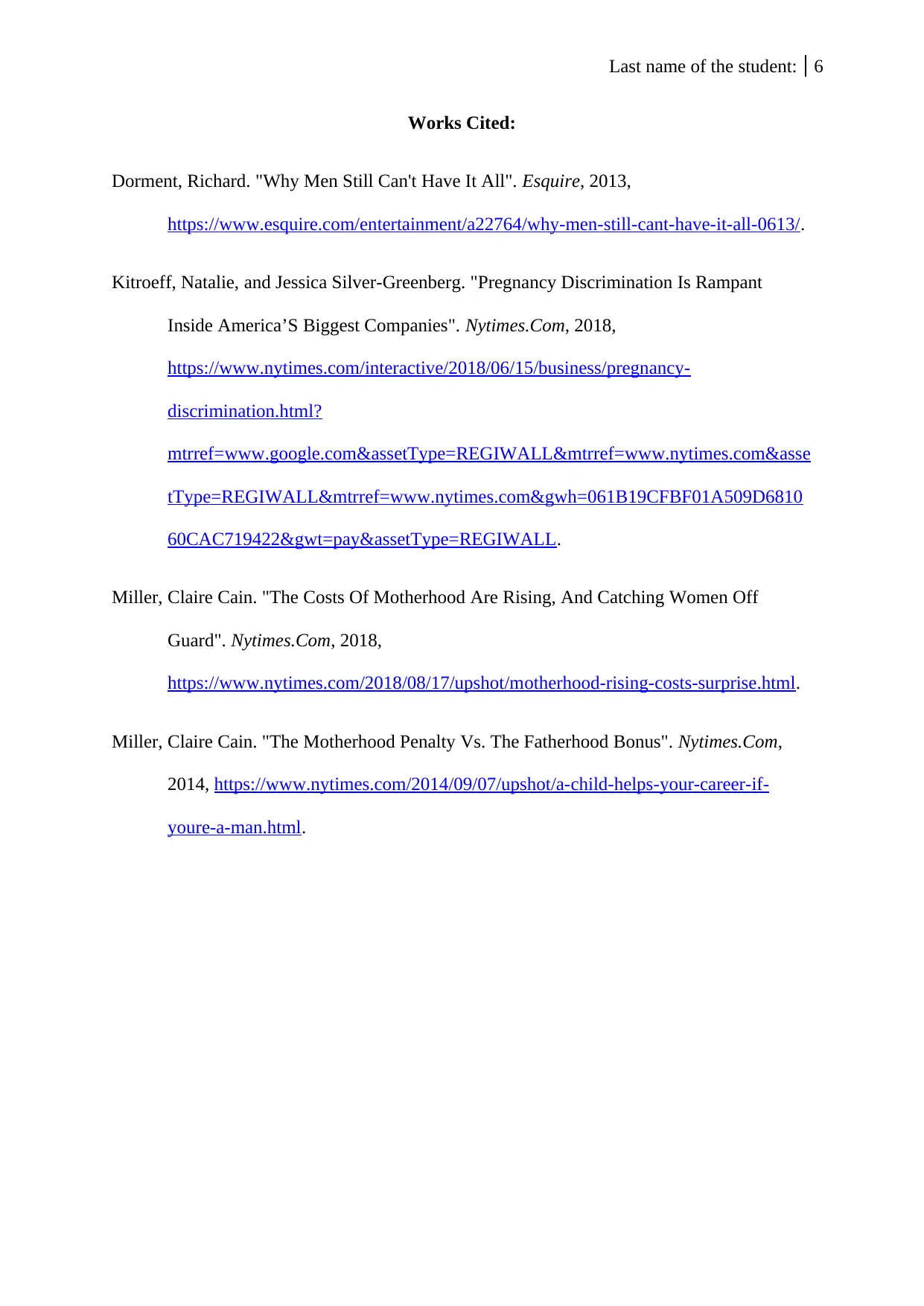
Last name of the student: 6
Works Cited:
Dorment, Richard. "Why Men Still Can't Have It All". Esquire, 2013,
https://www.esquire.com/entertainment/a22764/why-men-still-cant-have-it-all-0613/.
Kitroeff, Natalie, and Jessica Silver-Greenberg. "Pregnancy Discrimination Is Rampant
Inside America’S Biggest Companies". Nytimes.Com, 2018,
https://www.nytimes.com/interactive/2018/06/15/business/pregnancy-
discrimination.html?
mtrref=www.google.com&assetType=REGIWALL&mtrref=www.nytimes.com&asse
tType=REGIWALL&mtrref=www.nytimes.com&gwh=061B19CFBF01A509D6810
60CAC719422&gwt=pay&assetType=REGIWALL.
Miller, Claire Cain. "The Costs Of Motherhood Are Rising, And Catching Women Off
Guard". Nytimes.Com, 2018,
https://www.nytimes.com/2018/08/17/upshot/motherhood-rising-costs-surprise.html.
Miller, Claire Cain. "The Motherhood Penalty Vs. The Fatherhood Bonus". Nytimes.Com,
2014, https://www.nytimes.com/2014/09/07/upshot/a-child-helps-your-career-if-
youre-a-man.html.
Works Cited:
Dorment, Richard. "Why Men Still Can't Have It All". Esquire, 2013,
https://www.esquire.com/entertainment/a22764/why-men-still-cant-have-it-all-0613/.
Kitroeff, Natalie, and Jessica Silver-Greenberg. "Pregnancy Discrimination Is Rampant
Inside America’S Biggest Companies". Nytimes.Com, 2018,
https://www.nytimes.com/interactive/2018/06/15/business/pregnancy-
discrimination.html?
mtrref=www.google.com&assetType=REGIWALL&mtrref=www.nytimes.com&asse
tType=REGIWALL&mtrref=www.nytimes.com&gwh=061B19CFBF01A509D6810
60CAC719422&gwt=pay&assetType=REGIWALL.
Miller, Claire Cain. "The Costs Of Motherhood Are Rising, And Catching Women Off
Guard". Nytimes.Com, 2018,
https://www.nytimes.com/2018/08/17/upshot/motherhood-rising-costs-surprise.html.
Miller, Claire Cain. "The Motherhood Penalty Vs. The Fatherhood Bonus". Nytimes.Com,
2014, https://www.nytimes.com/2014/09/07/upshot/a-child-helps-your-career-if-
youre-a-man.html.
⊘ This is a preview!⊘
Do you want full access?
Subscribe today to unlock all pages.

Trusted by 1+ million students worldwide
1 out of 6
Related Documents
Your All-in-One AI-Powered Toolkit for Academic Success.
+13062052269
info@desklib.com
Available 24*7 on WhatsApp / Email
![[object Object]](/_next/static/media/star-bottom.7253800d.svg)
Unlock your academic potential
Copyright © 2020–2025 A2Z Services. All Rights Reserved. Developed and managed by ZUCOL.



